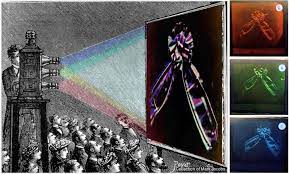The History of Photography
Photography has been a passion of mine for several years now. In fact, the background image of my blog page is one I took myself! It is a beautiful art medium that forces you to really take in what's around you and teaches you to look at things from different perspectives. Photography is used everywhere in daily life, for news, catalogs, art, preserving memories, education, etc. Without photography, the world would be at quite a loss.
Photography has technically existed since the 14th Century BC. Aristotle, followed by Chinese philosophers in the 15th Century BC had described the basic principles of the Camera Obscura, which operates on pinhole image formation. Light enters a hole in the boxy body of the Camera Obscura, projecting an image upside down that can then be traced on paper.
The negative photograph was another major development in photography history because it moved the technology away from light tracing to light capture to create images. In 1717, Johann Schulze discovered that silver nitrate darkens when exposed to light and thus negative photographs were born. A negative is what it sounds like: the reverse of a normal photograph; it will be darker in spots that received the most light exposure and vice versa.
In 1826, Joseph Nicéphore Niépce took the first true camera photograph, the Niépce Heliograph, using a sheet of pewter covered in chemicals to capture the image. At this point in photography, wet-plate photography methods used chemicals on glass plates and, due to the aqueous nature of the materials, photos had to be developed immediately in darkrooms for a long period of time. With the later invention of dry-plate photography, which used gelatin in place of glass, photographs could be stored and developed later. This was a significant development because photographers were no longer limited to locations with access to darkrooms.
The Daguerrotype process used silver-plated copper sheets in order to produce sharp positive photographs. This was a major landmark because it reduced the exposure time and eliminated the middle step of developing negative photographs. Daguerrotypes opened the door to commercial photography, mostly for portraits, but the drawback was that you could not make multiple prints from the original. The Calotype process offered a solution, it produced a paper negative that could then be made into a multiple positive prints without the need for a darkroom, however it still had a longer exposure time and an extra step for development, so it was not as popular.

The next major breakthrough in photography was the first color photograph, taken of a tartan ribbon by Scottish physicist James Maxwell in 1861. Maxwell took three separate images, each taken through one of three color filters: red, green, and blue and then layered them to create a composite that combined the three colors.
"Horse in Motion" was the first photographic sequence of movement, captured by Eadweard Muybridge in 1878. He used a rig of 24 cameras set up along a racetrack to take a sequence of pictures as a horse galloped by. This was the precursor to motion pictures.
Photography began to reach the public after George Eastman invented the Kodak in 1888. The Kodak was revolutionary for its use of film rolls to allow for multiple pictures to be taken in quick succession.
Not long after the Kodak, the Leica Camera was invented in Germany in 1925. This was one of the first small, compact cameras with smaller film. The Leica Camera was a major development in photography history because its size made it more portable and convenient for photographers.
Fast forward to 2024, and we now have incredible digital cameras and pocket-sized smart phones. They even have built-in and manual exposure and aperture settings, high definition photos, and large memory storage. Photography has never been so complicated yet so easy at the same time, and I can't take a picture without remembering where it all began!


Comments
Post a Comment